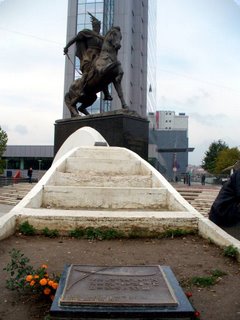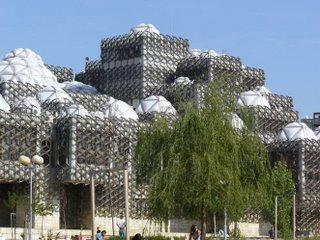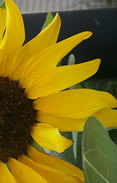I really liked the atmosphere of the place, and I was impressed with the huge amount of optimism the locals display, in spite of the relative poverty and uncertainty that surrounds them. There are lots of young people on the streets (more than half of Kosovo's population is under 25) and one of their most favorite activities is to sit at the table of one of the numerous cafés and drink coffee (everything goes by the name macchiato).
Here come some snapshots of Pristina, not sure if they can convey the real feel of the place...

This is the symbolic center of the city, a cummulation of markers: most obvious is the statue of Gjergj Kastrioti aka Skanderbeg, a 15th century prince who fought and was victorious against the Turks. He is the most famous of the Albanian rulers and the national hero par excellence. The original of this statues is the center of Tirana, the capital of Albania. Besides the statue is a small plaque marking the kilometer 0, the beginning of all roads in Kosovo. And behind Skanderbeg the new government building of the soon- to- be indepenendent Kosovo.

This is a more recent hero, the founder of the Kosovo Liberation Army, the guerilla group that opposed the Serbian forces on their way to remove the Albanian population from Kosovo in the late 1990s.

And another local contemporary hero, Adem Jashari (about whom my friend Zhiva told me so very much), whose larger-than-life poster dominates the Sports Complex. Adem was also a fighter against the Serbs, who ended up dead together with his entire extended family in a legendary battle in March 1998.

But Pristina is not just about men with guns. Those are the signs of the brutal recent past of this place. This is on the contrary a place of peace and spiritual meetings, one of the oldest mosques in town. Notice the three men wearing the typical Kosovo Albanian white (and egg-shaped, I should say) hat, called plis.

This is another example of an older architecture style, characteristic of the region, but rare to find in Pristina whose defining features (at least in the downtown area) date mostly from the communist period.

But there are some modern buildings, for example this high-rise which hosts the headquarters of the OSCE mission in Kosovo. In the distance you can see the residential neighborhoods located on the soft hills surrounding the city, where there are mostly smaller houses and villas.

Yes, what IS this building, you may ask? This strange construction hosts the university library and is build by a Croatian architect some time in the 1980s (if I get my years right). The coupoles are said to be an abstract representation inspired either by the human brain (!) or by the typical white Albanian hat (see mosque picture above).

Does this giant peace sign really mean the end of violence here? I would certainly say so.

1 comment:
Hi, Anamaria,
Great pictures, and interesting insights. Greetings from Tirana, Albania
Post a Comment